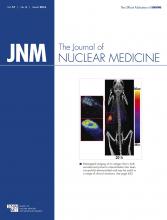Abstract
The aim of our study was to create a novel Gaussian mixture modeling (GMM) pipeline to model the complementary information derived from18F-FDG PET and diffusion-weighted MRI (DW-MRI) to separate the tumor microenvironment into relevant tissue compartments and follow the development of these compartments longitudinally. Methods: Serial 18F-FDG PET and apparent diffusion coefficient (ADC) maps derived from DW-MR images of NCI-H460 xenograft tumors were coregistered, and a population-based GMM was implemented on the complementary imaging data. The tumor microenvironment was segmented into 3 distinct regions and correlated with histology. ANCOVA was applied to gauge how well the total tumor volume was a predictor for the ADC and 18F-FDG, or if ADC was a good predictor of 18F-FDG for average values in the whole tumor or average necrotic and viable tissues. Results: The coregistered PET/MR images were in excellent agreement with histology, both visually and quantitatively, and allowed for validation of the last-time-point measurements. Strong correlations were found for the necrotic (r = 0.88) and viable fractions (r = 0.87) between histology and clustering. The GMM provided probabilities for each compartment with uncertainties expressed as a mixture of tissues in which the resolution of scans was inadequate to accurately separate tissues. The ANCOVA suggested that both ADC and 18F-FDG in the whole tumor (P = 0.0009, P = 0.02) as well as necrotic (P = 0.008, P = 0.02) and viable (P = 0.003, P = 0.01) tissues were a positive, linear function of total tumor volume. ADC proved to be a positive predictor of 18F-FDG in the whole tumor (P = 0.001) and necrotic (P = 0.02) and viable (P = 0.0001) tissues. Conclusion: The complementary information of 18F-FDG and ADC longitudinal measurements in xenograft tumors allows for segmentation into distinct tissues when using the novel GMM pipeline. Leveraging the power of multiparametric PET/MRI in this manner has the potential to take the assessment of disease outcome beyond RECIST and could provide an important impact to the field of precision medicine.
Footnotes
Published online Dec. 10, 2015.
- © 2016 by the Society of Nuclear Medicine and Molecular Imaging, Inc.







